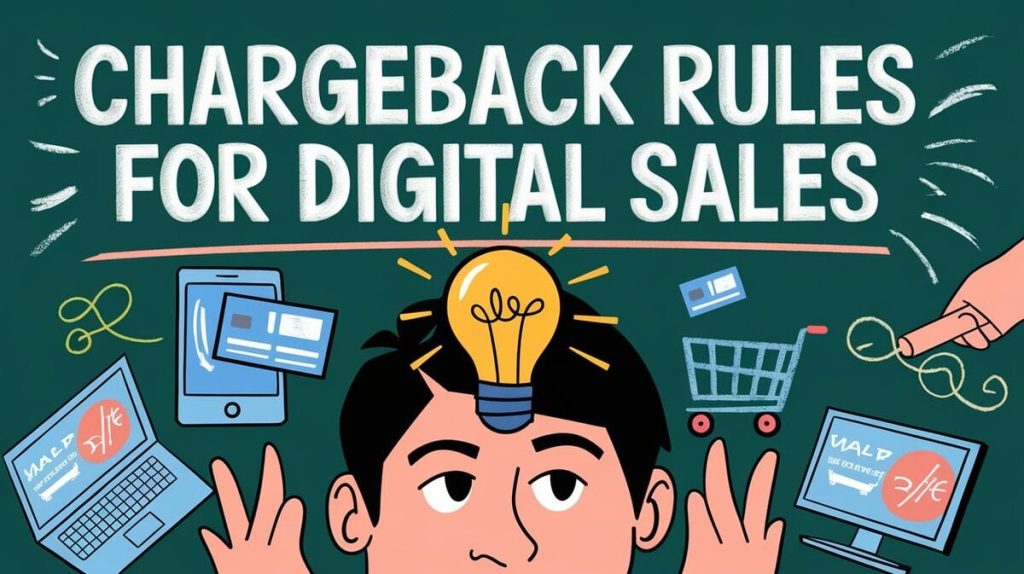Introduction
Chargebacks are a crucial issue for businesses that sell digital products or services. A chargeback occurs when a customer disputes a transaction with their bank or card issuer, forcing the merchant to return the funds. While designed to protect consumers, chargebacks can negatively impact merchants, especially those dealing in digital goods where disputes are more frequent due to the intangible nature of the products.
This guide explains chargeback rules for digital goods, how to minimize disputes, and the consequences of high chargeback ratios. We’ll provide actionable strategies supported by data, along with tables to clarify essential information.
1. What is a Chargeback?
A chargeback is a reversal of funds initiated by the customer’s bank. Chargebacks protect consumers from fraud but can lead to financial losses for merchants. For digital sales, chargebacks are more common due to product misunderstandings, fraud claims, and subscription issues.
Common Reasons for Chargebacks in Digital Sales:
- Fraudulent Transactions: Nearly 60% of chargebacks in digital sales result from fraud-related claims (source: Checkout.com).
- Unauthorized Purchases: Customers often dispute transactions they don’t recognize, especially if billing descriptors are unclear.
- Product Not Delivered or Not as Described: With no physical product, customers often claim they didn’t receive the item or it didn’t match the description.
- Subscription Cancellations: Issues with recurring billing can trigger chargebacks when customers forget about subscriptions or fail to cancel them properly.

2. Chargeback Rules for Digital Goods
Chargeback rules vary by card networks like Visa, Mastercard, American Express, and Discover. Each network sets guidelines for disputing chargebacks, time limits for filing, and the evidence merchants must provide to defend against claims.
Chargeback Time Limits by Major Card Networks:
| Card Network | Customer Dispute Window | Merchant Response Window |
|---|---|---|
| Visa | 120 days | 20 days |
| Mastercard | 120 days | 45 days |
| American Express | 120 days | 20 days |
| Discover | 120 days | 20 days |
Merchant Response Guidelines:
- Provide Compelling Evidence: Merchants must submit proof such as delivery confirmation, IP logs, or user data to dispute the chargeback.
- Use Clear Billing Descriptors: Ensure the billing statement clearly identifies your business and the nature of the product to avoid disputes.
- Meet Response Deadlines: Missing deadlines will almost always result in the loss of the dispute.
Recommendation: Merchants can benefit from working with payment processors experienced in digital sales. Merchanto.org, an official partner of Visa and Mastercard, offers advanced chargeback prevention and dispute management tools. Learn more at Merchanto.org.
3. Reasons for Chargebacks in Digital Sales
Chargebacks are common in digital sales due to the nature of the products, which are intangible and often misunderstood by consumers. Below are the primary reasons for chargebacks in this industry:
Top 4 Reasons for Digital Chargebacks:
- Fraudulent Transactions: Nearly 60% of digital chargebacks stem from claims of unauthorized transactions (source: Mastercard).
- Non-Delivery: Customers often claim they never received the digital goods, even though the product was delivered electronically.
- Goods Not as Described: Customers may allege that the product didn’t meet the expectations set by the merchant’s description.
- Recurring Billing Disputes: Subscription services frequently encounter chargebacks when customers forget to cancel or don’t realize they signed up for recurring payments.
| Reason for Chargeback | Percentage |
|---|---|
| Fraudulent Transactions | 60% |
| Non-Delivery | 25% |
| Goods Not as Described | 10% |
| Subscription Issues | 5% |
Prevention Strategies:
- Send Immediate Purchase Confirmations: Email or text customers immediately after their purchase, providing order details and how to access the product.
- Require Activation or Registration: Having customers activate or register the digital product creates an additional layer of verification.
- Transparent Refund Policies: Make your refund and cancellation policies easy to find and understand.

4. Best Practices for Chargeback Prevention
Effective chargeback prevention reduces both financial losses and damage to your reputation. For digital merchants, adopting practical measures can significantly lower the likelihood of disputes.
Key Practices to Prevent Chargebacks:
- Fraud Detection Tools: Implement fraud detection systems that analyze real-time transaction data. These tools screen for unusual activity, reducing fraud-related chargebacks by 50% (source: Stripe.com).
- Clear Policies: Ensure that terms of service, cancellation, and refund policies are visible and easy to understand.
- Responsive Customer Support: 56% of customers file chargebacks when they can’t resolve an issue directly with the merchant (source: Braintree.com). Swift response times can help address concerns before they escalate.
- Two-Factor Authentication (2FA): Adding an extra layer of security through 2FA can reduce fraud-related chargebacks by up to 35%.
Effectiveness of Fraud Prevention Tools:
| Tool | Chargeback Reduction (%) | Average ROI (%) |
|---|---|---|
| Real-Time Fraud Filters | 50% | 800% |
| Address Verification | 40% | 700% |
| 2FA | 35% | 600% |
5. Consequences of High Chargeback Ratios
Card networks monitor merchants’ chargeback-to-transaction ratios to identify excessive disputes. If a merchant exceeds these thresholds, they may face penalties, increased fees, or even account termination. Below are the typical chargeback thresholds for each major network:
| Card Network | Chargeback Ratio | Consequences |
|---|---|---|
| Visa | 0.9% | Enrolled in Visa Dispute Monitoring Program |
| Mastercard | 1% | Excessive Chargeback Program |
| Discover | 0.75% | Account termination risk |
| American Express | 1.5% | Penalty fees and account monitoring |
How to Lower Your Chargeback Ratio:
- Automated Alerts: Set up systems to notify you when a chargeback is filed, allowing quick responses.
- Track Chargeback Trends: Monitor disputes over time to identify patterns and adjust your processes accordingly.
- Issue Refunds Before Disputes: Offer refunds proactively in situations where customer dissatisfaction could lead to a chargeback.
Chargeback Penalties:
Exceeding chargeback thresholds can lead to penalties from card networks, including increased fees, enrollment in chargeback monitoring programs, and potential account termination. Merchants enrolled in these programs typically face monthly fines until their ratios return to acceptable levels (source: Mastercard Excessive Chargeback Program).
Conclusion
Chargebacks in digital sales are a complex but manageable issue. Understanding the rules and adhering to best practices can significantly reduce disputes. By focusing on fraud detection, clear communication, and proactive support, merchants can minimize chargebacks and protect their business from excessive fees and penalties.
By following the strategies outlined in this guide, digital merchants can effectively manage chargebacks, ensuring smoother operations and reduced financial losses.



